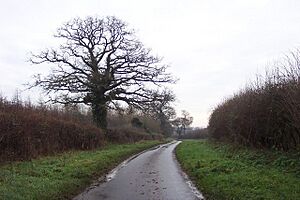Welsh Way facts for kids
The Welsh Way was an important ancient path in Britain. It started as a trade route during the British Iron Age, which was a time long ago when people used iron tools. This path helped people trade goods between South Wales and the Oxford area of England, crossing the Cotswold Hills.
Contents
What Was the Welsh Way?
The Welsh Way was more than just a simple path. It was a vital connection for trade and travel. It linked the highest point on the River Thames where boats could travel, near Lechlade, to the lowest place where people could cross the River Severn at Gloucester.
An Ancient Trade Route
In the Iron Age, the Welsh Way was a main route for trading. It helped people move goods and communicate across different regions. This path was not always a single, clear road. Sometimes it split into a few different routes, like one going through Quenington and another through Fairford. This was called its "braided nature."
Roman Road Improvements
Later, after the Romans took over Britain, they also used the Welsh Way. The Roman army improved parts of the path. They used it to connect their own important roads, like Akeman Street and the Fosse Way. This shows how useful the Welsh Way was for different groups of people over time.
Drovers' Path to London
Much later, from the 1200s to the 1700s, the Welsh Way became famous for another reason. It was the main route for cattle drovers from Wales. These drovers were people who walked large groups of cattle all the way to London to sell them. During this time, the path was sometimes called "Tame's Way." This name came from a wealthy family of merchants in the Cotswolds.
The Welsh Way Today
Today, parts of the Welsh Way still exist. You can find it as a named lane in some areas. For example, it leaves the main road between Gloucester and Cirencester before Duntisbourne. It then passes through places like Barnsley and Ready Token. From there, it continues to Fairford and Lechlade. Eventually, it connects with another famous ancient path called The Ridgeway near Wantage.


